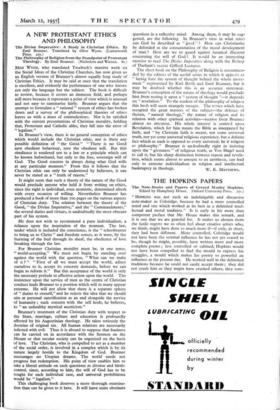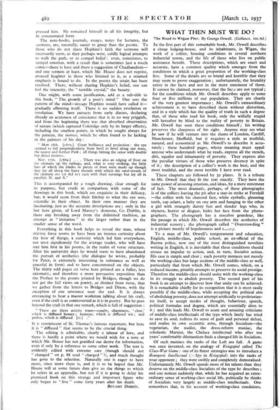The Note-Books and Papers of Gerard Manley Hopkins. Edited by
Humphrey House. (Oxford University Press. 25s.)
• THE HOPKINS PAPERS
The Note-Books and Papers of Gerard Manley Hopkins. Edited by Humphrey House. (Oxford University Press. 25s.)
" HOPiaNs was not such an indefatigable and discursive note-maker as Coleridge, because he had a more controlled mind and one which worked at its best in a delimited Intel. lectual and moral tradition." It is early in his more than competent preface that Mr. House makes this remark, and it is one that we are grateful for. It makes us abstain from the futile regrets we so often feel about creative artists who, we think, might have done so much more if—if only, in short, they had been different. More controlled, Coleridge would not have been the seminal influence he has not yet ceased to be, though he might, possibly, have written more and more complete poems ; less controlled or cabined, Hopkins would not have been compelled to fmd the mould to express his struggles, a mould which makes his poetry so powerful an influence at the present day. He worked well in the delimited traditions because he could not easily accept them ; they did not crush him as they might have crushed others, they corn-
pressed him. He remained himself in all his integrity, but in concentrated form.
The note-books, journals, essays, notes for lectures, the sermons, are, naturally, easier to grasp than the poems. To those who do not share Hopkins's faith the sermons will necessarily seem, as they perhaps were, coldly logical attempts to walk the path, or to compel belief : even, sometimes, to compel emotion, with a result that is sometimes just a touch comic—there is here and there a suggestion of Chadbandism- and one sermon at least, which Mr. House does not reprint, aroused laughter in those who listened to it, as a strained emphasis is bound to do. In the poems the strain has been resolved. There, without sharing Hopkins's belief, one can feel the intensity, the " terrible crystal," the beauty.
One might, with some justification, add as a sub-title to this book, " The growth of a poet's mind." One sees the pattern of the mind—inscape Hopkins would have called it— gradually affirming itself. There is no sudden revelation or revolution. We have extracts from early diaries, declaring already an acuteness of conscience that is in no way priggish, and from the beginning there was that absorbed observation
of nature (which captured Coleridge only by its larger effects), including the smallest points, in which he sought always for the pattern, the instress, which he often found to be lacking in the painters of his day : " MAT x8th. [1870.] Great brilliancy and projection : the eye seemed to fall perpendicularly from level to level along our trees, the nearer and further Park ; all things hitting the sense with double but direct instress.
Nov. t7th. [1869.] . . . There was also an edging of frost on the clematis up the railings, and, what is very striking, the little bars of which the blades or pieces of frost were made up though they lay all along the hairy threads with which the seed-vessels of the clematis are set did net turn with their turnings but lay all in parallels N. and S."
This is accompanied by a rough drawing, clear enough for its purpose, but crude in comparison with some of the
drawings - in this book, which are exquisite in their delicacy, but, it would seem from their fidelity to what the eye sees, scientific in their object. In their own manner they are fascinating, just as the accurate descriptions are ; only in the last here given, of Lord Massey's demesne, Co. Dublin, is there any breaking away from the delimited tradition, an attempt at " imitation " in the larger rather than in the smaller sense of the word.
Everything in this book helps to reveal the man, whose driving force seems to have been an intense curiosity about
the how of things, a curiosity which led him everywhere, not least significantly for the average reader, who will have
met him first in his poems, in the realm of verse structure. After his university days he would seem to have abandoned the pursuit of aesthetics (the dialogue he wrote, probably for Pater, is extremely interesting in substance as well as graceful in form) and to have concentrated on the objects.
The thirty odd pages on verse here printed are a fuller, less axiomatic, and therefore a more persuasive exposition than the Preface to the poems printed by Bridges, though we do
not get the full views on poetry, as distinct from verse, that we gather from the letters to Bridges and Dixon, with the exception of one utterance near the end. It is always entrancing to hear a master workman talking about his craft, even if the craft is as controversial as it is in poetry. But he goes beyond the craft in that one remark, which is full of suggestion :
" There are three artistic tones—candor, chasteness, ' clear,' which is diffused beauty ; humour, which is diffused wit ; and pathos, which is diffused [sic] ."
Jr is reminiscent of St. Thomas's famous statement, but here it is " diffused " that seems to be the crucial thing.
The editing is admirable, clearly a labour of love, and there is hardly a point where we would wish for a note at which Mr. House has not gratified our desire for information, even if only by a reference to some other work. The text is evidently edited with extreme care (though should not " changed " on p. 88 read " charged " ?), and much thought has gone to the selection. Naturally one is eager to have more, since more there is, and it is to be hoped that Mr.
House will at some future date give us the things to which he refers in an appendix, but not if it is going to delay his
promised book on this strange and important figure who only began to " live " some forty years after his death.
SONANLY DOBRtE.















































 Previous page
Previous page